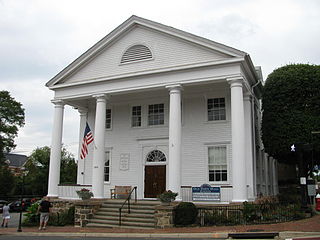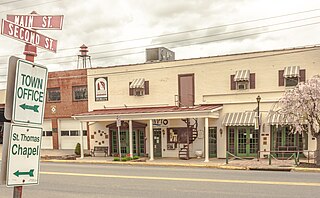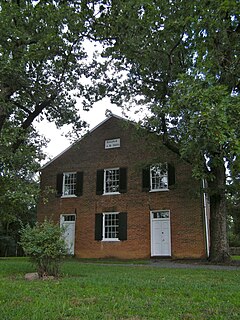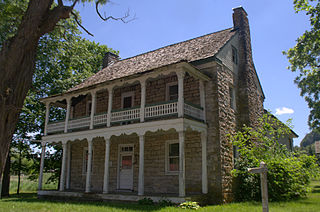
Buildings, sites, districts, and objects in Virginia listed on the National Register of Historic Places:

Pocahontas Historic District is a national historic district located at Pocahontas in the Pocahontas coalfield, Tazewell County, Virginia. It is near Pocahontas Exhibition Coal Mine, a U.S. National Historic Landmark which was Mine No. 1 of the Pocahontas coalfield. The district encompasses 17 contributing buildings and 1 contributing structure in the town of Pocahontas. Notable buildings include the City Hall (1895), the stone Episcopal Methodist Church, Catholic Church, the old brick medical dispensary, a Synagogue, the first millinery shop in the coalfields and a Masonic Hall.

Aquia Creek sandstone is a type of brown to light-gray freestone used extensively in building construction in Washington, D.C. in the late 18th and early 19th centuries. Quarried at Aquia Creek in Stafford County, Virginia, the stone was valuable for its ease of shaping and the quarry's proximity to the tidewater portion of the Potomac River, 45 miles south of Washington.

The Public Quarry at Government Island in Stafford County, Virginia is the principal source of Aquia Creek sandstone, a building stone used in many of the early government buildings in Washington, D.C., including the U.S. Capitol and the White House. A quarry was established just off the Potomac River at Wigginton's Island on Aquia Creek by George Brent after 1694, providing stone for tombstones and to houses and churches in northern Virginia, including Gunston Hall, Christ Church in Alexandria, Virginia, Mount Airy in Richmond County, Virginia, and Aquia Church, as well as steps and walkways at George Washington's Mount Vernon. Washington selected Aquia sandstone as the primary material for use in Washington's government buildings. Acting on the government's behalf, the Wigginton's Island quarry was purchased by Pierre Charles L'Enfant in 1791, becoming known afterward as Government Island.

The City of Fairfax Historic District is a national historic district located at Fairfax, Virginia. It encompasses 28 contributing buildings in the central business district of Fairfax. Notable buildings include the Old Town Hall, which was built in 1900; the Barbour Building; First National Bank of Fairfax; Ford Building; Marsh House; McHugh & Hoffman Building; Rust Building; and Truro Church. Located in the district are the separately listed Historic Fairfax County Courthouse, Old Fairfax County Jail, and Ratcliffe-Logan-Allison House.

Opequon Presbyterian Church is a historic Presbyterian church located near Winchester, in Frederick County, Virginia. It was built in 1897, and is a one-story, gable-roofed, random-rubble stone church. It features Gothic-arched colored-glass, one-over-one windows and a three-stage corner bell tower containing an entrance. Also on the property are four burying grounds with the oldest marked grave site dated to 1742.

Old Chapel is a historic Episcopal church building located near Millwood, Clarke County, Virginia. Old Chapel is now the oldest Episcopal church building still in use west of the Blue Ridge Mountains. It was listed on the National Register of Historic Places in 1973. In 2014, the Chapel Rural Historic District was recognized, and which encompasses both Cunningham parish churches, discussed below, as well as approximately 700 other structures and an area of nearly 10,500 acres.

White Post Historic District is a national historic district located at White Post, Clarke County, Virginia. It encompasses 23 contributing buildings and 1 contributing object in the crossroads village of White Post. The contributing object is the white-painted marker which Thomas, Sixth Lord Fairfax, had erected in the 1760s to point the way to Greenway Court, his nearby estate.

John Hite House, also known as Springdale, is a historic home located near Bartonsville, Frederick County, Virginia. The original house was built in 1753, and is of native limestone laid in irregular ashlar with some random-coursed limestone rubble used on its secondary walls. It was remodeled in the Greek Revival style about 1835–40 and again in the Colonial Revival style about 1900. The front facade features a 19th-century four-bay, two-story portico. Also on the property are the contributing stone ruins of what is believed to be Jost Hite's tavern/house of the 1730s, a stone shed, and small wood-frame spring house. Springdale was originally, the home of Jost Hite, the earliest white settler in the lower Shenandoah Valley. Colonel John I. Hite, son of Jost Hite, built the Springdale family dwelling.

Frederick County Courthouse is a historic county courthouse located at Winchester, Frederick County, Virginia. It was built in 1840, and is a two-story, rectangular, brick building on a stone foundation and partial basement in the Greek Revival style. It measures 50 feet by 90 feet, and features a pedimented Doric order portico and a gabled roof surmounted by a cupola. Also on the property is a contributing Confederate monument, dedicated in 1916, consisting of a bronze statue of a soldier on a stone base. The building houses the Old Court House Civil War Museum.

Crumley–Lynn–Lodge House is a historic home located near Winchester, Frederick County, Virginia. The earliest section was built about 1759, and was a 1 1/2-story, log section raised to a full two stories about 1850. About 1830, a two-story, Federal style brick section was added. A two-story frame section was added to the original log section in 1987–1994. The front facade features a folk Victorian-style front porch with square columns, sawn brackets and pendants, and plain handrail and balusters. Also on the property are the contributing mid-19th-century brick granary, and log meat house, as well as a late-19th century corn crib, and the stone foundation of a barn.

St. Thomas Chapel, also known as St. Thomas Episcopal Church or St. Thomas Protestant Episcopal Chapel, is a historic building located at 7854 Church Street in Middletown, Frederick County, Virginia, United States. Built in the 1830s, regular services were held at the Episcopal church for almost 100 years. The building has been restored twice, once after being heavily damaged during the Civil War, and again in the 1960s. The church was added to the Virginia Landmarks Register (VLR) and the National Register of Historic Places (NRHP) in 1973.

Middletown Historic District is a national historic district located at Middletown, Frederick County, Virginia. It encompasses 234 contributing buildings in the town of Middletown. The majority of the buildings are residential and their associated outbuildings. The non-residential historic structures include four specialty shops, a theater, four churches, the Town Hall, two former schools, three warehouses and an inn. Notable buildings include Middletown Mission Church, Grace United Methodist Church (1897), Mt. Zion Church (1880), the former Middletown School (1909), the Town Hall (1880), The Wayside Inn, Larrick's Tavern, Wayside Theatre (1946), and Lafolette House. Located in the district and separately listed is the St. Thomas Chapel.

High Banks, also known as the Helm-Clevenger House, is a historic home and farm located near Stephenson, Frederick County, Virginia. The house was built about 1753, and is a two-story, three bay by two bay, center-hall, double-pile, limestone dwelling. It has a one-story, two-bay by three-bay frame addition and a frame rear wing. The front porch and interior features detailing in the late Greek Revival added about 1858. Also on the property are a contributing foundation and partial wall of a post-Civil War bank barn and an 18th-century icehouse pit, both of stone.

Mount Zion Old School Baptist Church, also known as Mount Zion Primitive Baptist Church and Mount Zion Old School Predestinarian Baptist Church, is a historic Primitive Baptist church located at Gilberts Corner, Loudoun County, Virginia. It is now maintained by the Northern Virginia Regional Park Authority: the property including the adjoining cemetery is open from dawn to dusk and the church itself open on the fourth Sunday of various months, or by reservation for weddings and events.

The Cedar Hill Church and Cemeteries are located in historic Rockbridge County, Virginia. The small log church, which also served as a schoolhouse, was built in 1874 evoking the history of Rockbridge County's African American community. The land was given by a white farmer named John Replogle and transferred to” Trustees for the Colored Baptist Congregation” A cemetery was established behind the church, marked today by a scattering of field stone memorials. Because of the rocky ground, a new cemetery was laid out at a separate location around 1890 and is still in use. The Cedar Hill congregation was formed shortly after the Civil War. It consisted of African Americans that basically worked and lived on white-owned farms. The meetings were held in a log dwelling southwest of the present church. Later, the congregation met under a large oak tree that stood approximately one and a half miles west of the present church. Cedar Hill's oak tree meeting-place was similar to the brush arbor churches that many freedman congregations established in Virginia following the Civil war as temporary shelter. It is said that many members were buried near that oak tree that was called as the "Gospel Tree". The tree was destroyed by lightning around 1890, but the stump is still visible and a limb from it is kept at the present church as a historic memento.

Old Stone Tavern, also known as Rock House, is a historic inn and tavern located near Atkins, Smyth County, Virginia. It was built about 1815, and is a two-story, three bay, limestone structure with a central-hall plan. A frame rear ell was added in the mid-19th century. It has a side gable roof. The front facade features a mid-19th century porch supported by chamfered columns connected on each level by a decorative cyma frieze and sawn balustrade. The tavern was built to accommodate travelers in the heavy migration through Cumberland Gap to the west in the early 19th century.

Old Kentucky Turnpike Historic District is a national historic district located at Cedar Bluff, Tazewell County, Virginia. The district encompasses 35 contributing buildings, 3 contributing sites, and 3 contributing structures along Indian Creek Road and Indian Creek. They date from the late-19th to mid-20th centuries. Notable resources include the concrete bridge, steel railroad trestle, Cecil-Watkins House, Ratliff House, Cedar Bluff Presbyterian Church, the boyhood home of Governor George C. Peery (1873–1952), Thomas Cubine House, Gillespie House, the Old Cedar Bluff High School, Cedar Bluff High School (1906), and the Old Cedar Bluff Town Hall. Also located in the district is the separately listed Clinch Valley Roller Mills.



























